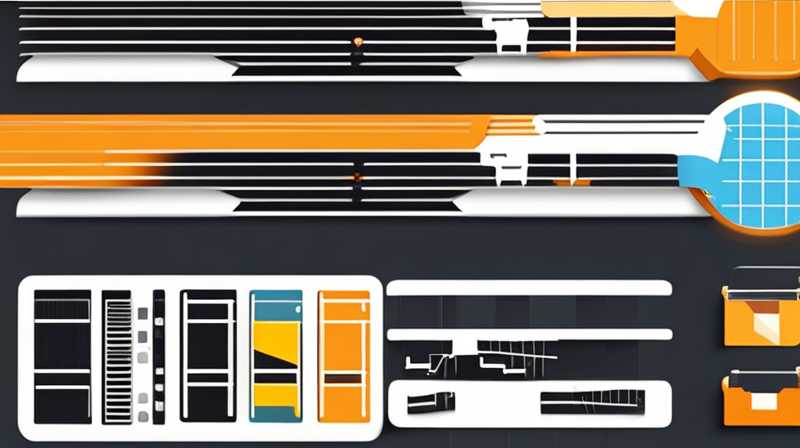
1. Proper planning is essential before installation, 2. Choose suitable solar lights for outdoor use, 3. Follow installation steps meticulously, 4. Ensure optimal positioning for maximum sunlight exposure.
In selecting outdoor solar lights for football fields, the initial priority involves an assessment of the location, understanding the direction of sunlight, and considering the surrounding environment which can affect light performance. A comprehensive plan should incorporate these considerations to ensure maximum efficiency and functionality of the lights.
1. PLANNING AND PREPARATION
Successful installation of outdoor solar lights begins with specific planning and thorough preparation. Assessing the area’s needs is imperative; understanding factors such as the size of the football field, typical usage hours, and desired illumination levels will lead to informed decisions on the type and quantity of solar lights required.
Identifying potential obstacles is also crucial. Tall trees, adjacent buildings, or signage may cast shadows, reducing the effectiveness of solar lights. Consider conducting a shadow analysis during peak sunlight hours to ensure that chosen positions receive adequate sunlight throughout the day. This phase requires careful deliberation to optimize installation and light efficiency subsequently.
2. CHOOSING THE RIGHT SOLAR LIGHTS
Once planning is thoroughly performed, the next step involves selecting appropriate solar lights tailored to outdoor environments. Numerous factors should guide this selection, including brightness, battery capacity, and durability. Brightness is typically measured in lumens; for football fields, selecting lights that provide a higher lumen output is recommended to ensure adequate visibility during evening matches.
Battery capacity matters significantly, as it dictates the duration for which the lights will operate once fully charged. Lighting systems equipped with larger batteries can provide longer working hours, which is crucial for events extending into the night. Equally important is the construction of the solar lights; they should be designed to withstand outdoor elements, thus ensuring longevity and reliable performance.
3. INSTALLATION PROCEDURE
Following the selection of suitable solar lights, the actual installation must be approached with precision. Begin by laying out all materials and reviewing the manufacturer’s guidelines to familiarize yourself with specific installation requirements. Depending on the model, some solar lights may need mounting brackets or stakes, thus necessitating appropriate tools for a seamless installation.
Establishing a secure foundation for the lights is crucial. If the lights are to be mounted on poles, ensure that holes are dug to the correct depth, allowing for stability against strong winds. This firm installation base will help prevent the lights from being displaced or damaged during severe weather conditions. Furthermore, pay attention to wiring if necessary; connections should be secured to avoid any disconnections or damages in the future.
4. POSITIONING FOR OPTIMAL LIGHTING
The positioning of solar lights significantly influences their effectiveness. Positioning should aim for maximum sun exposure while considering the coverage required across the football field. Ensure lights are spaced sufficiently apart, providing uniform illumination without creating overly bright or dark spots on the field.
Adjustment of angle might be required based on seasonal changes; thus, a pivot arm or adjustable mount could offer flexibility. Such adjustments ensure lights continue to receive adequate sunlight, maintaining performance throughout the year. Conducting a trial run after installation will help evaluate the light’s effectiveness, allowing for any necessary repositioning.
FAQs
WHAT TYPES OF SOLAR LIGHTS ARE BEST FOR OUTDOOR FOOTBALL FIELDS?
When selecting solar lights for outdoor football fields, focusing on those that emit high lumens is crucial for ensuring visibility. LED solar lights often serve as a preferred choice due to their impressive brightness and energy efficiency. Additionally, solar flood lights equipped with a motion sensor feature can enhance security, activating upon detecting movement. Durability in construction is also essential, as these lights are exposed to various weather conditions. Look for products with weather-resistant ratings, and consider options that come with adjustable brightness settings, allowing adaptability depending on the event’s timing and needs.
HOW LONG DO SOLAR LIGHTS LAST ON A FULL CHARGE?
The operational longevity of solar lights on a full charge varies based on several factors, including battery capacity, the efficiency of solar panels, and weather conditions. Typically, when fully charged, quality outdoor solar lights can illuminate for six to twelve hours, depending on their specifications. For optimal performance, regular maintenance is advisable; cleaning the solar panels ensures maximum sunlight absorption. Additionally, some models feature light sensors that turn them off during daylight hours, preserving battery power. Understanding this factor will help users manage their expectations regarding the duration of lighting during events.
CAN SOLAR LIGHTS FUNCTION IN CLOUDY WEATHER?
While solar lights predominantly rely on sunlight, they still function in cloudy or overcast conditions, although their performance may be hindered. Solar panels can absorb indirect sunlight, providing energy even when direct sunlight isn’t available. However, it’s essential to recognize that the charging time might be extended, leading to shorter operational times after dusk. Regular assessments of the solar panels and battery conditions are recommended during such weather to optimize performance. Models equipped with larger battery reserves may compensate better for reduced charging, allowing extended usage in less-than-ideal conditions.
The installation of outdoor football solar lights encompasses various stages requiring thoughtful execution. The initial planning phase highlights the importance of assessing the field conditions and surroundings to effectively position and select appropriate lighting solutions. One must meticulously choose lights offering ample brightness and durability, ensuring long-lasting performance against weather elements. Conducting a precise installation is critical, focusing on ensuring stable positioning and understanding the significance of angle adjustments as seasons change. Ultimately, regularly evaluating the lighting efficiency post-installation helps ensure that the lights deliver the necessary illumination for games, training, or events held at night. Engaging thoroughly in each of these aspects allows for the successful incorporation of solar lighting into outdoor environments, fostering not just functionality but enhancing safety and visibility for all participants involved.
Original article by NenPower, If reposted, please credit the source: https://nenpower.com/blog/how-to-install-outdoor-football-solar-lights/


